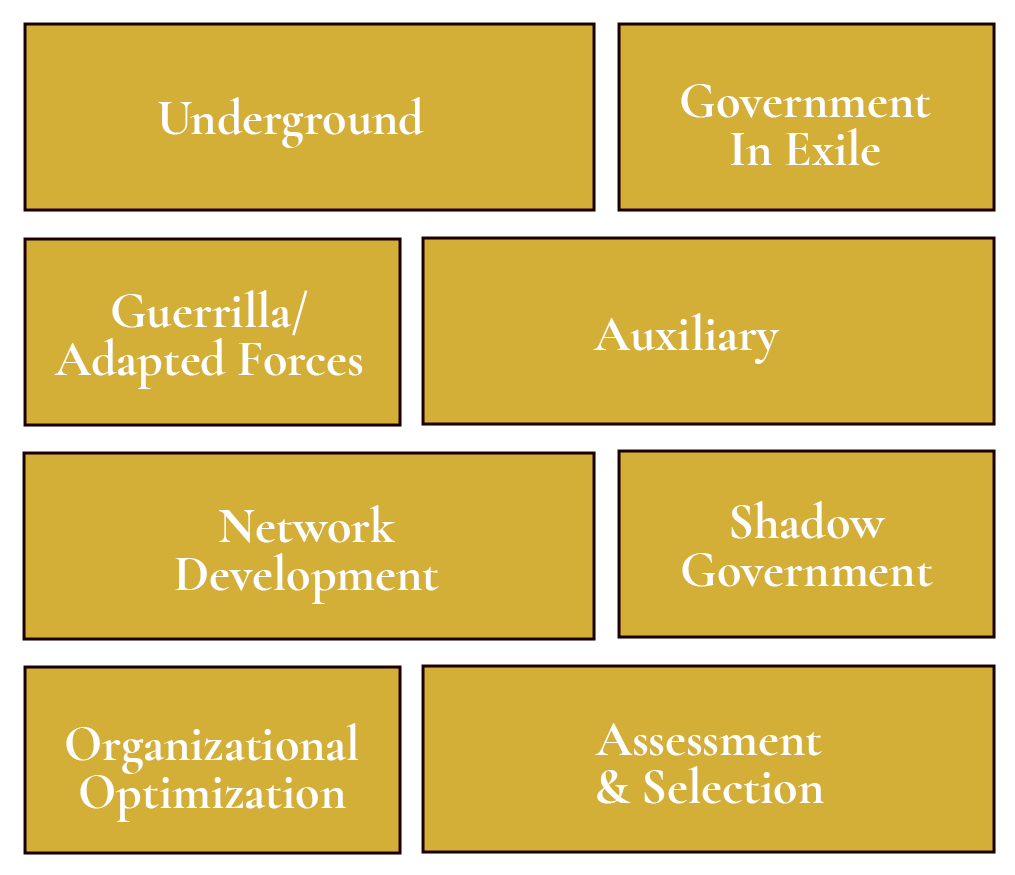Resistance Leader
Development
Whether civilian or military, resistance leaders are critical to the success of the organization by providing vision, strategic direction, inspiration, empowerment, and effectively balancing risk and action. Due to the unique challenges and circumstances resistance leaders will face in times of crisis, they must be assessed, selected, developed, and mentored to ensure their effectiveness.

Resistance leaders and their followers require clear roles and responsibilities to ensure the entire organization is optimized for successful resistance. Defining and developing the roles and responsibilities of every leader and follower in the organizations sets the stage for proper training, individual development, and ideally, professionalization within the roles, prior to a crisis. This level of detailed preparation increases the chances of success of the individual and organization.
Successful resistance efforts combine strengths of both military and civilian leaders. Leadership requirements during R2 campaigns require similar foundational leadership skills found in public and private sectors. Additional skills are required for managing compartmented and security-conscious resistance organizations. These special leadership skills are not found in traditional leadership courses.
Being a resistance leader is tough. Individual leaders must carefully plan their every move to ensure they remain clandestine and undetected, while leading larger organizations. With little first-hand information, they rely on others for their safety and awareness. The unique pressures of a clandestine leader require special training to build resilient resistance leaders capable weathering the rigors of clandestine life and clandestine leadership and excelling under these unique circumstances.
Decision Making
For the government-in-exile, disconnected from the day-to-day, on-the-ground fight for the Nation, strategic decisions made prior to the crisis set the stage for the Nation’s success under occupation.
For the shadow government, the day-to-day, on-the-ground fight requires strategic and operational decision-making skills where critical thinking, innovation, and the ability to understand and mitigate risk are essential to successful outcomes.
Leadership of undergrounds, auxiliaries, guerrillas/adapted forces, and the political wings of the resistance each require both traditional and special leadership skills. Where a leader with a military background may excel as a guerrilla or adapted force commander, they may fail miserably as a leader in the underground. Leading resistance organizations requires skills training, experience, and putting the right leaders into the right positions within the organization to optimize positive impacts on an organization.
Negotiation skills are incredibly important for resistance leaders. Throughout the crisis, the resistance leaders will find themselves conducting multiple negotiations to gain resources, maintain support, develop partnerships, and co-opt proxies, and if the resistance is successful, negotiate the terms of surrender of the occupying forces. Negotiation skills arm the resistance leaders with the tools they will need to carry on operations during an extended crisis.
& Selection
The importance of assessment and selection is a documented requirement across the international special operations community. A critical part of this process includes psychological assessments which rely on “people data” to identify individuals with the right dispositions, risk tolerances, leadership abilities, and decision-making capacities. Use of these tools makes it easier to identify the right individual for a specific job or even assigning a specific team where they add the most value. An organization that is manned and optimized from the start based on people data has a much greater chance of success. Without these tools, organizations are left with trial and error, wasting precious time and resources.
Strategic communications is a critical resistance leader skill, used to confidently communicate up, down, and laterally within the organization. This skill also informs national resistance narratives and sets the stage for larger campaigns to strengthen the resolve of the Nation under occupation and subvert the occupier. The skills include developing compelling narratives, identifying key communications nodes and stakeholders, and finding innovative and creative ways to “get the message out.”
RESILIENCE & RESISTANCE
CONCEPTUAL DEVELOPMENT
Developing and operationalizing a Nation’s resilience and resistance concept takes disciplined action bounded by the Nation’s legal and resourcing constraints. Operationalization of these concepts requires thorough planning, compartmentalization, and integration of civilian and military capabilities. These concepts are then fully integrated into national defense programs, strategies, and plans, and provide the foundational doctrine for the whole-of-society participation in resistance.

Developing national resilience and resistance capabilities requires detailed program strategies and plans for resourcing and implementation. The starting point for this effort is the U.S. and NATO Doctrine, Organization, Training, Material, Leadership and Education, Personnel, and Facilities (DOTMLPF) analysis tool. In addition to DOTMLPF, the NATO “I” for Interoperability, and two common U.S. additions, “P” for Policy and “A” for Authorities, are included to ensure all aspects of a program are analyzed to identify requirements and integrate capabilities. This includes ensuring interoperability with NATO partners, when necessary, as well as identifying the unique policies and legal authorities that are required to build whole-of-society, pre-crisis resilience and resistance capabilities.
Integration
Historically, the most successful resistance efforts against occupiers included both military and civilian aspects of the organization. The civilian aspects begin with the concept of civilian oversight over the military, but continues to the smallest unit of action in civic society, the non-violent resistance efforts of the individual citizen. A military-only or military-heavy resilience and resistance effort will likely be less effective in a conflict due to the lack of integration with the civilian government leaders at all levels. Thus, a national resilience and resistance effort is stronger when the military and civilian capacities of the nations are fully integrated.
Considerations
Developing pre-crisis, whole-of-nation resilience and resistance capabilities must be done within the legal frameworks of the nation, which at times can constrain these efforts. In most cases, legal constraints are meant to safeguard civil liberties, limit government overreach, as well as limit the blurring of inherently law enforcement and internal security roles with military roles in defense of a nation. However, these legal constraints can simultaneously hamper resilience and resistance development efforts. When this is the case, and depending on the national will, specific legal changes to a country’s bodies of laws and regulations are required, and may be accepted by the population for the good of the nation, to allow resilience and resistance efforts. Additionally, consideration must be given to the potential legal status for various types of members within the overall resistance organization prior to a crisis. Each member of the organization must have a clear understanding of their individual legal protections granted by the Geneva Conventions and international law, so they understand the personal risks they are accepting by participating in these efforts.
Plan Integration
Integration of resilience and resistance concepts into joint strategies and plans ensures operationalization of these efforts. A viable national, pre-crisis resilience and resistance is a powerful irregular deterrent when added to national defense strategies. Further integration of resistance into national, bilateral, and multilateral defense plans allows for greater overall impact. As a key part of the joint force’s military capacity, adding resistance to occupation opens a “second front” for an occupier to have to deal with while also defending the occupied terrain from outside interventions. In total, these integrated efforts require the occupier to expend time and resources to address these complex problems in multiple domains.
Compartmentalization of resistance efforts are critical to the overall security of these efforts. Structural and functional compartmentalization ensures that individuals do not have enough information to expose large portions of these organizations. Ideally, structural compartmentalization provides critical “circuit breakers” which limit damage due to penetrations, raids, or strikes to ensure the overall resilience of the organization. Functional compartmentalization is the use of clandestine tradecraft to limit the visible connections between individuals within the network to deny the occupier from linking individuals to each other or the resistance effort. Compartmentalization requires detailed planning, proactive management of interactions between individuals to limit exposure, and strict need-to-know protocols—all bound by solid counterintelligence practices.
Survive, Report, Evacuate, and Participate (SREP) skills are baseline skills for building a resilient citizenry. The ability of citizens to survive a crisis, whether natural or man-made, starts at home with proper training and at least minimal supplies to survive for short periods of time when government-provided services are disrupted. The ability of citizens to then provide information and intelligence to the proper authorities sets the stage for the active participation of the citizens, not only for their own well-being, but that of their fellow citizens, and empowers the government to respond. Depending on the situation and the capacity of the individual citizens, evacuation may be the best option to clear the disaster area or areas of conflict to minimize collateral damage. Finally, for the citizen who decides to be an active participant—such as volunteering to support disaster response and recovery, or in the case of an occupation, participate in non-violent resistance or support armed resistance—the state can provide them with the skills training commensurate with their risk tolerance for participating.
Counterintelligence is critical throughout the conceptual development of resilience and resistance efforts. Disciplined development ensures a secure organization from the start, ideally making it difficult for the adversary to penetrate the effort or gain enough insights to disrupt the efforts in the development or execution stages. Ideally, counterintelligence practices are strong enough that if deterrence fails, the occupier will be forced to expend inordinate amounts of time and resources trying to defeat the clandestine organizations, like the underground, but will be thwarted at every turn due to the resilience built into the organizations from the start.
Non-violent resistance is a skill that any member of a resistance can employ to effectively disrupt and frustrate the occupier. Coordinated non-violent resistance, controlled by local resistance organizations or nationally by the shadow government, can have even more significant impact on the occupier. Providing the population with these skills prior to a conflict has a significant and positive psychological impact on the population, increasing their confidence that they can play a role in a resistance, even if only non-violently. These skills should be trained, developed, and exercised through various programs during pre-crisis periods to ensure they can be employed in a crisis.
Resistance
Organizational Development
Establishing a secure resistance organization consisting of an underground, auxiliary, guerrilla or adapted forces, and a political wing is never easy, but it is easier to do this prior to a crisis than during one. Resilient resistance organization development requires thorough organizational planning, disciplined selection of key members, good tradecraft, and counterintelligence to minimize exposure of key personnel and the opportunities for hostile actors to penetrate key portions of organization during its development, all with a goal of making an organization that can weather the extreme pressures of an occupier’s efforts to defeat the organization.

The process of developing secure and compartmented underground organizations is the most difficult, time consuming, and tradecraft heavy part of the overall resistance organization development. However, the underground is the most important part of the entire resistance organization and serves as the cornerstone and foundation of the resistance organization. Historically, the underground has been the largest part of the resistance organization, but the least studied due to its clandestine nature. For every guerrilla or adaptive force member, there should be three to five underground members. The survival of the underground is the center of gravity for any resistance movement and thus requires the correct clandestine compartmentalization—both in form and function—to ensure the resilience and longevity of this element of the resistance organization.
The government-in-exile is a critical political component that escapes the occupation and establishes the national footprint in a third-party country, leveraging the Nation’s embassy infrastructure abroad. This entity is responsible for garnering and coordinating international support for the resistance effort, including the support of diaspora communities abroad, providing legal justification for the resistance, and providing strategic guidance to the in-country resistance. It also establishes the legal bounds of the collaborative government—the portions of the government allowed to collaborate with the occupier to meet the basic needs of the population while simultaneously not aiding and abetting the occupier.
Adapted forces
The guerrilla/adapted forces are the easiest forces to recruit and develop, but are also at the greatest risk during a crisis. Since this resistance element will be conducting kinetic operations against the occupier, they will take the most casualties and become the focus of the counter-resistance efforts by the occupier. This force’s size, capacity, and operational areas are driven heavily by the ability of the underground and auxiliary to support these formations, as well as the terrain this force will fight on. In rural areas, larger guerrilla/adapted forces can operate more easily, although technology will increasingly make rural sanctuaries less tenable. In urban areas, guerrillas/adapted forces will be constrained in their size and overtness, likely operating as clandestine cells, like the underground.
The auxiliary is the second most important element of resistance organizations and provides several functions, such as intelligence collection, transportation, and logistics support. This element remains hidden in plain sight but under the control of the underground. Developing the auxiliary also requires detailed planning and identification of the resource and logistics capacity required to support both the underground and other paramilitary forces.
The process of developing clandestine networks of any type requires a clear understanding of the purpose or logic for the network, how the network will function clandestinely, and lastly, what form or structural compartmentalization will be used. Together, these three steps result in the formulation of a network or even a larger networked organization, all ideally developed with resilience in mind from the start to achieve the ultimate goal of any resistance—to win by not losing and outlast the occupier.
The shadow government is the government entity within the occupied territory leading and sanctioning the day-to-day resistance by the public-private-and-civic capacity of the Nation. The shadow government is at the most risk and combines both civilian and military capacity. They shadow government is responsible for the direct fight with the occupier, and will control the overall National resistance within the legal bounds set forth by the government-in-exile.
Optimization
The resistance organizational development process can leverage the power of people data to ensure organizational optimization, from the tactical to the strategic level. Putting the right individuals into the right positions throughout the organization is a critical capacity to set conditions for the organization’s success.
Assessing and selecting key individual for positions within the tactical to the strategic levels of the organization ensures the right individuals are in the right positions, optimizing the organization to achieve the desired outcomes. The importance of assessment and selection is well-founded in the international special operations community. A critical part of this process is psychological assessments which rely on “people data” to identify individuals with the right dispositions, risk tolerances, leadership abilities, and decision-making capacity. People data is the game changer for leader assessment and selection. Emerging use of these tools makes it easier to identify the right individual for a specific job or even a specific team where they add the most value. This is called job targeting and team optimization, respectively. An organization that is manned and optimized from the start based on people data has a much greater chance of success. Without these tools, organizations are left with trial and error as the way of determining individual fit, wasting precious time and resources, luxury resistance organizations do not have during a life-or-death struggle.
TYPES OF SUPPORT VALENS GLOBAL PROVIDES
TO RESILIENCE & RESISTANCE DEVELOPMENT
Whether civilian or military, establishing a resilience and resistance national effort requires the right kind of training venues based on the tasks, scales, and level of expertise desired. Experiential training focused not on what to think, but how to think and apply various historical lessons or lessons learned, combined with situational training, provides the tools for the transfer of expertise. This expertise, plus deep understanding of Nation’s whole-of-society and the threat, sets the conditions for the development of sound solutions to tactical, operational, and strategic resilience and resistance problems during the development, as well as execution, of these efforts.

We can host or lead seminars of varying lengths and topics to provide a forum for advanced learning. We use adult learning models and expert facilitation to explore an operational or strategic resilience or resistance problem faced by our clients, and then lead the seminar to discover potential solutions. Our subject matter experts ensure that any solutions are doctrinally and operationally sound.
We can provide subject matter experts to work with exercise staffs to support exercise scenario development, train role-players and backside support personnel in key aspects of resilience and resistance to increase realism, support the planning and execution at various organizational levels—tactical, operational, or strategic, and support after action reviews.
Studies
We leverage pre-packaged or client-specific historical cases studies as a tool to help clients explore their specific operational and strategic problems related to resilience and resistance. Historical case studies provide an unclassified tool for us to lead and facilitate the client’s self-discovery of operational and strategic solutions to their identified gaps, issues, and problems using adult learning models. We are agnostic as to the clients preferred tactics, techniques, procedures, or tradecraft, but will ensure the solutions do not violate key principles of resilience and resistance.
Our subject matter experts provide exceptional expertise on resilience and resistance development based on years of experience with similar efforts, advanced studies, and deep special operations backgrounds to not only support concept development, but also operationalization of these efforts.
We provide various types of risk assessments, including assessments of operations, organizations, programs, strategies, plans, and security to identify potential areas of concern or risk for the clients. We then use risk mitigation strategies to develop options to minimize or negate these issues for the client.
We provide tailored advanced training up to the PhD level based on the client’s needs. We build upon the skills and education attained through venues, such as a national or international military education and training institutions, as well as those provided by U.S. Special Operations Command (USSOCOM), Theater Special Operations Commands (TSOC), and the NATO Special Operations Headquarters (NSHQ). Regardless of the advanced training topics, we always focus on application—our expertise is applicable to real-world problems and provides viable solutions at the tactical, operational, and strategic levels.
We provide exceptional operational and strategic wargaming capabilities and scenario development tailored to client needs, including unilateral, bilateral, and multilateral gaming capacity. Our wargames provide realistic, scenario-based immersive environments that force participants to confront real-world resilience and resistance dilemmas. The goal of these games is two-fold—provide a realistic training environment that mirrors real-life dilemmas to all participants to wrestle with tough problems in peacetime to better prepare them for crisis, and give the participants the space to Fail, Learn, Adapt, and Grow (FLAG).
We provide subject matter expertise to study operational aspects of resilience and resistance capabilities. Based on the analysis and findings, our experts provide recommendations or validation of various operational and strategic concepts.
